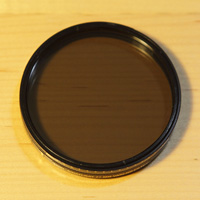In this article I’ll tell you why you might use a variable ND filter for video, what it is, and how to use it to trick the exposure metering of the Canon 5D Mark II’s video mode. Read on to find out more.
This image is a frame capture from a video clip that I shot this morning with the 5D Mark II. The lighting is direct early morning sunlight, just after sunrise, so it was pretty bright. The camera originally wanted to use an aperture of f/11, but I forced it to open up to f/2.8 so that I could get the shallow depth of field you see here. But wait, there’s no manual controls in video mode. So how’d I do that? With a variable neutral density (ND) filter.

So what is a variable ND filter? It’s a screw-on filter that provides adjustable light reduction. It has a rotating front element (like a circular polarizer), which allows you to control the light transmission of the filter. They’re commonly used by landscape photographers to get slower shutter speeds when photographing moving water. The one I have is the Singh-Ray Vari-ND. It provides about 2 to 8 stops of light control depending on the setting.
 |
 |
 |
Okay, so why did I need to use one for video? There’s two reasons. The first one is light control. If I were shooting stills, I could go all the way up to the camera’s maximum shutter speed of 1/8000 second and I’d have no trouble shooting at f/2.8 without filters. But in video mode the shutter speed is limited, possibly as low as 1/125 according to some reports. So the ND filter gives me back some of the light control that I lost.
Here’s the really interesting part. The variable ND filter also gives me the ability to trick the camera’s metering system and regain some semblance of manual control over the video mode. If a scene is too bright, the camera decides to stop down the aperture. By adding the ND filter, you can use it to reduce the light intensity until the camera decides to open the aperture again. However, something weird happens here. The 5D Mark II first pushes up the ISO before opening the aperture, and then the ISO stays quite high with the new aperture. What’s really cool about having a variable ND filter is that you can fix this by backing off on the filter and letting a little more light in again. It seems that the camera gets “stuck” at the new aperture and will reduce the ISO before closing down the aperture again. Then you can lock the exposure with * and you’re good to go.
Here’s an example sequence of meter readings that illustrates my point. Let’s assume that the shutter speed is staying constant throughout the sequence (in reality it may fluctuate some):
|
If you’re shooting with a zoom lens, you might even be able to combine this with my trick for controlling shutter speed.